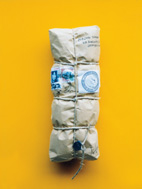|
|
|
 |
 |
La parola all'autore
Il pacco nasconde un'opera, ma potrebbe anche essere semplice contenitore vuoto, cioè opera d'arte esso stesso: chi lo possiede deve decidere se tenerlo come gli è giunto, oppure aprirlo, scoprendo il contenitore, di cui non è però certo dell'esistenza.
Nel caso esso mancasse, il proprietario avrebbe vanificato l'oggetto, condotto dalla sua curiosità in un inedito gioco d'azzardo, dove creazione-illusione-distruzione si susseguono con inevitabile necessità. Il gesto diventa rischio: rivelazione di un qualcosa nascosto o annientamento irreversibile, scoperta gioiosa o amara sorpresa.
E il pacco assume quasi i connotati di una metafora di tanti momenti della nostra esistenza: attraenti quando sono ancora celati nel futuro, spesso deludenti quando si vivono. Luigi Sergi
Luigi Sergi, nato in Puglia a Presicce, vive a lavora a Novara. Inizia giovanissimo l'attività artistica, dedicandosi sia alla pittura che alla scultura.
Tra il '60 e la prima metà degli anni '70 frequenta l'Istituto d'arte e l'Accademia delle Belle Arti di Lecce dove, nel 1975, si diploma in scultura. Trasferitosi a Roma, studia Psicologia della forma e, una volta stabilitosi a Novara, assume l'incarico di docente di Materie Artistiche, continuando peraltro ad approfondire la propria ricerca sulle varie tecniche cromatiche e plastiche.
A partire dal 1982 espone in svariate mostre personali, che testimoniano una matura acquisizione delle esperienze. È nel 1983 che indirizza l'attenzione verso un percorso conoscitivo differente: il "pacco", metafora della vita in quanto mistero, enigma o sorpresa che, forse, per essere gustata, non va svelata. La poetica del pacco-opera d'arte offre spunti di riflessione sulla difficoltà di interpretare la realtà e sulla necessità di indagarla, penetrandola attraverso forme non immediatamente decodificabili. Apprezzato per il valore della produzione artistica, diversificata ma costante e molto personale, Luigi Sergi ha preso parte a numerose collettive e personali in tutta Italia e alcune sue opere sono esposte in musei e collezioni private.
A word from the author
The pack hides a work of art, but it could also easily be a simple empty container, i.e. a work of art in itself: it's up to the person who has it to decide whether to keep it as is or open it and discover what's in the container, though its existence isn't certain. If there's nothing there, the owner has ruined the object, driven by his curiosity in an unusual gamble, where creation-illusion-destruction follow on another with inevitable necessity.
The gesture become a risk: discovery of something hidden or irreversible destruction, a happy discovery or bitter surprise? And the pack almost takes on the nature of a metaphor for many a moment in our lives: attractive while still hidden by the future, often a disillusion once actually experienced. Luigi Sergi
Luigi Sergi, born in Puglia in Presicce, lives and works in Novara. He started his artistic career at an early age, dedicating himself to both painting and sculpture.
He attended the Institute of Art and the Academy of Fine Arts in Lecce in the 60s and early 70s, gaining his diploma in sculpture in 1975. He then moved to Rome and studied Psychology of Forms. Then, on settling in Novara, he taught Artistic Materials, while still continuing his own studies into the various chromatic and plastic techniques. Sergi started doing his own shows in 1982, proving his matured acquisition of experiences. In 1983 he turned his attention to a different conoscitive path: the "pack", a metaphor of life as a mystery, enigma or surprise that, maybe, to be tasted fully, should never be revealed.
The poetry of the pack/work of art makes one think about the difficulties involved in interpreting reality and the need to investigate, penetrating it through forms that aren't always immediately easy to understand.
Appreciated for the value of his diversified yet constant and highly personal art, Luigi Sergi has taken part in many joint and individual shows throughout Italy. Several of his works are exhibited in museums and private collections.
|
|
|

... svelare l'enigma?
tecnica mista,
cm 24x7x6,
montato su plexiglass
giallo 25x36, 1998
|